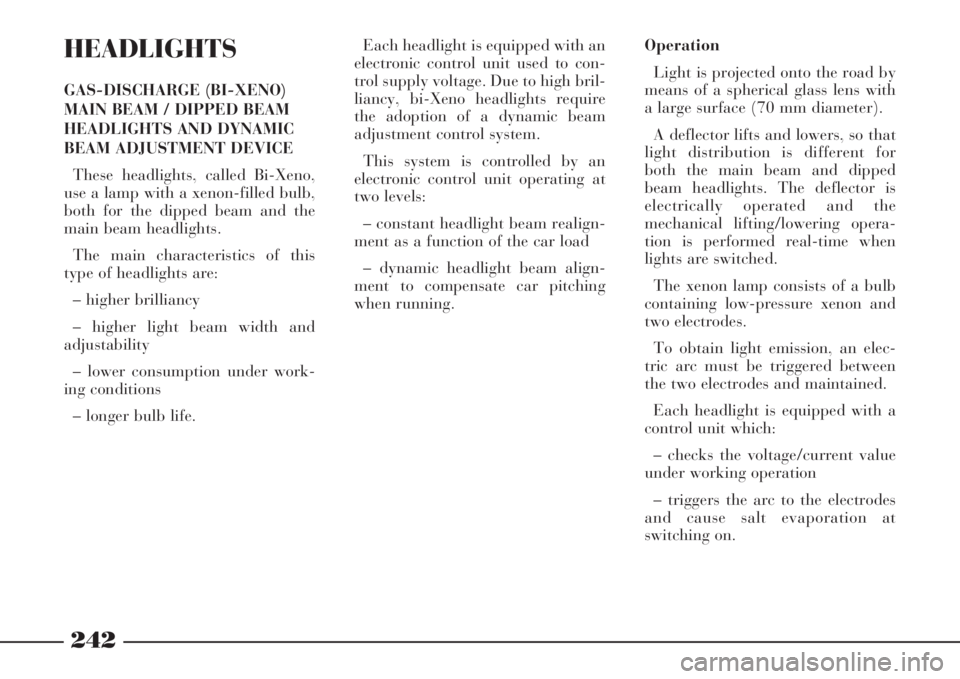width Lancia Thesis 2008 Owner handbook (in English)
[x] Cancel search | Manufacturer: LANCIA, Model Year: 2008, Model line: Thesis, Model: Lancia Thesis 2008Pages: 386, PDF Size: 4.96 MB
Page 108 of 386

107
INSTRUMENTS
SPEEDOMETER (fig. 103)
The speedometer shows the car
speed expressed in kilometres per
hour (km/h) and starts signalling
the speed when the car speed
exceeds approx. 4 km/h (see the
indications given in paragraph “At
the filling station").REV COUNTER (fig. 104)
If the needle is in the hazard sector
(the section with red lines) it shows
that the engine is over-revving. Do
not travel with the needle in this sec-
tor.
When the engine is idling, the rev
counter may show a gradual or sud-
den increase in engine speed,
according to the case. This is normal
and indicates the operation of the
climate control compressor or fans,
etc. In particular, a gradual varia-
tion in engine revolution speed safe-
guards battery charge.IMPORTANTThe hazard sectors
can present different widths and dif-
ferent full scale values according to
the various car versions.
IMPORTANTThe electronic injec-
tion control system will progressive-
ly cut off the flow of fuel when the
engine is over-revving and the
engine will consequently lose power.
fig. 103
L0A0232b
fig. 104
L0A0233b
Page 243 of 386

HEADLIGHTS
GAS-DISCHARGE (BI-XENO)
MAIN BEAM / DIPPED BEAM
HEADLIGHTS AND DYNAMIC
BEAM ADJUSTMENT DEVICE
These headlights, called Bi-Xeno,
use a lamp with a xenon-filled bulb,
both for the dipped beam and the
main beam headlights.
The main characteristics of this
type of headlights are:
– higher brilliancy
– higher light beam width and
adjustability
– lower consumption under work-
ing conditions
– longer bulb life.Each headlight is equipped with an
electronic control unit used to con-
trol supply voltage. Due to high bril-
liancy, bi-Xeno headlights require
the adoption of a dynamic beam
adjustment control system.
This system is controlled by an
electronic control unit operating at
two levels:
– constant headlight beam realign-
ment as a function of the car load
– dynamic headlight beam align-
ment to compensate car pitching
when running.Operation
Light is projected onto the road by
means of a spherical glass lens with
a large surface (70 mm diameter).
A deflector lifts and lowers, so that
light distribution is different for
both the main beam and dipped
beam headlights. The deflector is
electrically operated and the
mechanical lifting/lowering opera-
tion is performed real-time when
lights are switched.
The xenon lamp consists of a bulb
containing low-pressure xenon and
two electrodes.
To obtain light emission, an elec-
tric arc must be triggered between
the two electrodes and maintained.
Each headlight is equipped with a
control unit which:
– checks the voltage/current value
under working operation
– triggers the arc to the electrodes
and cause salt evaporation at
switching on.
242
Page 357 of 386

356
RIMS AND TYRES
Alloy rims or steel.
Tubeless tyres with radial carcass.
The homologated tyres are listed in
the log book.
IMPORTANTIn the event of dis-
crepancies between information
given in the Owner Handbook and
that shown in the Log Book, refer to
the latter one.
To ensure safety of the car in
movement, it must be fitted with
tyres of specified size and of the
same make and type on all wheels.
IMPORTANTDo not use inner
tubes with tubeless tyres. CORRECT TYRE READING
Below, please find the instructions
needed to understand the meaning
of the code stamped on the tyre, as
shown in fig. 6.
The code may be in one of the ways
given in the example.
Example:
225/50 R 17 94 W
or
225/50 ZR 17 94W
fig. 6
L0A0257b
225= Nominal width (S, distance
in mm between sides)
50= Percentage height/width
ratio (H/S)
R= Radial tyre
ZR= Radial tyre, with speed over
240 km/h
17= Rim diameter in inches (Ø)
94= Load index (capacity)
W= Maximum speed index.
Page 358 of 386

357
Maximum speed index
Q= up to 160 km/h
R= up to 170 km/h
S= up to 180 km/h
T= up to 190 km/h
U= up to 200 km/h
H= up to 210 km/h
V= over 210 km/h
ZR= over 240 km/h
W= up to 270 km/h
Y= up to 300 km/h
Maximum speed index
for snow tyres
QM + S= up to 160 km/h
TM + S= up to 190 km/h
HM + S= up to 210 km/h Load index (capacity)
60= 250 kg
61= 257 kg
62= 265 kg
63= 272 kg
64= 280 kg
65= 290 kg
66= 300 kg
67= 307 kg
68= 315 kg
69= 325 kg
70= 335 kg
71= 345 kg
72= 355 kg
73= 365 kg
74= 375 kg
75= 387 kg
76= 400 kg
77= 412 kg
78= 425 kg
79= 437 kg
80= 450 kg
81= 462 kg
82= 475 kg
83= 487 kg84= 500 kg
85= 515 kg
86= 530 kg
87= 545 kg
88= 560 kg
89= 580 kg
90= 600 kg
91= 615 kg
92= 630 kg
93= 650 kg
94= 670 kg
95
= 690 kg
96= 710 kg
97= 730 kg
98= 750 kg
99= 775 kg
100= 800 kg
101= 825 kg
102= 850 kg
103= 875 kg
104= 900 kg
105= 925 kg
106= 950 kg
CORRECT RIM
READING
Below, please find the instructions
needed to understand the meaning
of the code stamped on the rim, as
shown in fig. 6.
Example:7 J x 16 H2 39
7= rim width in inches (1)
J= rim drop centre outline (side
projection where the tyre
bead rests) (2)
16= rim nominal diameter in
inches (corresponds to diam-
eter of the tyre to be mount-
ed) (3=Ø)
H2= hump shape and number
(relief on the circumference
holding the tubeless tyre
bead on the rim)
39= wheel camber (distance
between rim point of contact
and wheel rim centre line)